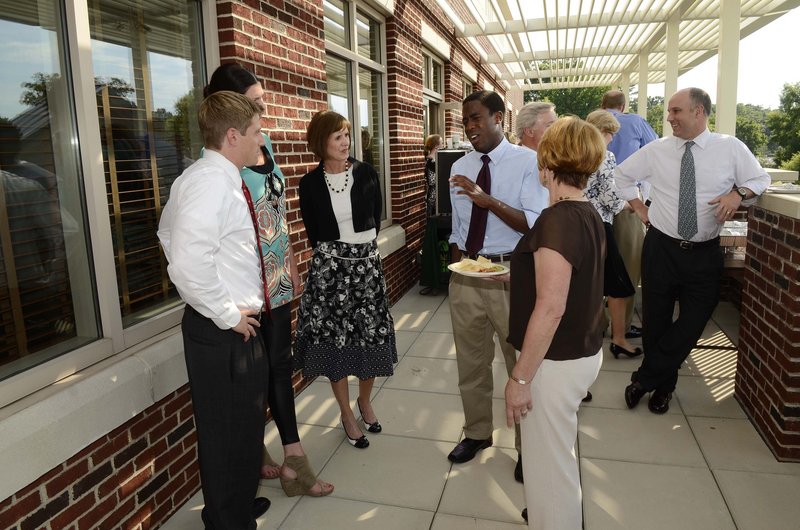Clients of law firm Johnston, Allison & Hord value that many of the same attorneys and staff have worked with them for decades.
Not surprisingly, that kind of longevity doesn’t happen by accident. It takes time, effort and money to create a work environment that begets low employee turnover.
But it’s well worth it, said Darrell Shealy, managing partner of the 101-year-old Charlotte, N.C., firm.
Because despite the stress of the job, it’d be hard to leave a business that gives employees $100 gas cards for their commutes in the throes of the recession. One that gives flowers, pedicures or gift cards on holidays and employee’s annual work anniversaries. One that throws a catered staff-appreciation party on the second floor balcony with a skyline view a half-dozen times a year.
“We do all we can to keep all our folks as happy as we can around here,” Shealy said.
The flashy perks of multi-billion-dollar corporations, such as Apple and Google (hello, nap pods, free dry-cleaning and on-site medical care), have publicly married the relationship between employees’ satisfaction and productivity. But whether a company employs thousands or a handful, workforce retention and engagement can directly affect margins.
Here’s one reason: Vacancies deal a blow to productivity, said John Bennett, a professor in Queens University’s McColl School of Business and the director of the school’s master’s program for executive coaching.
Add the often-lengthy process of recruiting, hiring and training an employee, and you’ve lost and invested a substantial amount of time and money before the new hire even contributes. Bennett said studies estimate that some businesses spend nearly the equivalent of that annual salary before the new hire starts producing.
But even without a vacancy, businesses can lose when employees are disengaged, or mentally “checked out,” he said.
“Whether they’re making $20,000, $50,000 or $1 million a year, all of that adds up,” Bennett said. “So it’s important for us to have fully engaged, competent people doing the right things in the right ways with the right resources.”
So while small business owners might not have the revenue to offer free shuttle services and gourmet chefs for three meals a day, some entrepreneurs have found their own ways to boost morale. And they’re attesting that perks — big or small — pay big dividends.
BUILD A CULTURE
Perks alone often aren’t enough to retain an employee, but they go a long way toward building a business’s culture, which is what often attracts them or drives them away, Bennett said.
Sharon Garfield owns Traditions, a high-end home furnishings shop in Charlotte. She has seven employees and can only afford to offer health benefits to her full-time employees. And yet her part-timers continue to come back.
She credits their loyalty with the work environment, which feels like family, she said.
Everyone on staff eats lunch together every day, and she’ll treat once or twice a week. She also keeps the back stocked with bread, condiments and deli meat for those who — like her — rarely find time to pack a lunch in the morning.
Employees also love the “Bottomless Mug” cards she buys from the Bruegger’s Bagels next door. Every January, Garfield spends about $1,000 on a handful of cards that entitle them to a year’s worth of free coffee, soda and tea.
And for her employee with back problems, she’ll lend him her monthly Massage Envy pass every few months.
Would employees stick around without those small perks? Garfield thinks so.
“But it’s an added benefit of working here and one of the first things someone will tell a new person,” she said.
KNOW YOUR EMPLOYEES
There’s no one-size-fits-all model for perks, experts say, so it’s important for business owners to discover what appeals most to their employees.
Les Hudson, a professor of strategic management in the McColl School of Business, used to be the CEO of textile manufacturer Dan River, Inc.
Because most of his employees had children, he said he gave many family-friendly rewards, such as tickets to a ball game.
On the other hand, Keith Luedeman, CEO of Charlotte-based online lender Goodmortgage.com, found that offering perks with a “cool factor” attracted millennials.
That’s why the company’s 44,000-square-foot office has a basketball court, a full gym, and a game room with everything from ping-pong and foosball to Nintendo Wii and shuffleboard.
Since Luedeman founded the business in 1999, it’s grown from three employees to 109.
“I know there’s a payoff,” he said. “I hear from my employees, ‘Hey, this matters. This makes a difference.’ And when they refer people, I know it’s because they’ve been talking about all the fun things in this place.”
MAKE EMPLOYEES FEEL APPRECIATED
Perks are great, Hudson said, but they’re just a facet of a larger goal: to make employees feel wanted and appreciated.
One free way to boost morale is to ask for employees’ advice, Hudson said. But, he added, “you have to be prepared to really examine what they’re telling you. Because if you don’t … you seem insincere. And that can do more damage.”
Send questions/comments to the editors.



Success. Please wait for the page to reload. If the page does not reload within 5 seconds, please refresh the page.
Enter your email and password to access comments.
Hi, to comment on stories you must . This profile is in addition to your subscription and website login.
Already have a commenting profile? .
Invalid username/password.
Please check your email to confirm and complete your registration.
Only subscribers are eligible to post comments. Please subscribe or login first for digital access. Here’s why.
Use the form below to reset your password. When you've submitted your account email, we will send an email with a reset code.